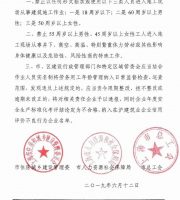[book donation activity] construction management difficulties, doubts and risk control [previous article] [free book donation activity] Preface: it is imperative to establish the concept of construction management in the whole life cycle of construction projects Doubts and risk control [engineering training] [Course appointment] 2020, the engineering training based on Party A’s thinking has been fully upgraded and the facts of the case have been put online
. 
Wanju company and Zhongcheng company signed the construction contract, which agreed that Zhongcheng company will construct the project of zone a of e-commerce industrial base contracted by Wanju company
. 
At the beginning of 2013, Zhongcheng company actually entered the site for construction
.
On February 12, 2015, Wanju company issued a letter of commitment, which stated that as of January 31, 2015, Wanju company still owed 40 million yuan to Zhongcheng company for the project, and promised Wanju company to pay the full amount before April 30, 2015, and pay 3% monthly interest as liquidated damages to Zhongcheng company
.
The liquidated damages will be paid on the 11th of each month
.
If the liquidated damages are not paid on schedule, 20000 yuan will be fined every day; The letter of commitment is recognized by Zhongcheng company
.
At the end of 2016, the project was shut down
.
Because Wanju company owed the project funds, Zhongcheng company appealed to the court to ask Wanju company to pay 198817194 yuan of project funds and 3% of monthly interest as agreed in the letter of commitment to pay liquidated damages
.
Wanju company argued that the liquidated damages were too high, and the court of first instance found that the amount of liquidated damages was too high and adjusted it down
.
Zhongcheng company filed an appeal against it
.
Gist of judgment 《 Article 29 of the interpretation of the Supreme People’s Court on Several Issues concerning the application of the contract law of the people’s Republic of China (2) stipulates that if a party claims that the agreed penalty is too high and requests to be appropriately reduced, the people’s court shall, on the basis of actual losses, take into account such comprehensive factors as the performance of the contract, the fault degree of the party and the expected interests, According to the principle of fairness and good faith to be measured, and make a ruling
.
According to the “letter of commitment” involved in the case, Wanju company confirmed that as of January 31, 2015, it still owed 40 million yuan for part of the project funds to Zhongcheng company, and promised to pay the full amount before April 30, 2015
.
During the period of project funds owed, Wanju company agreed to pay liquidated damages to Zhongcheng company on the 11th day of each month according to the standard of 3% per month
.
If it failed to pay the liquidated damages on schedule, it would be fined 20000 yuan per day
.
The agreement is the true intention of the parties
.
Wanju company defends that the penalty standard is too high, but it does not prove that the penalty is too high than the actual loss of Zhongcheng company
.
Wanju company failed to pay the project payment in accordance with the contract, which was the party in breach of the contract
.
Zhongcheng company did not breach the contract, and Zhongcheng company did not claim interest on the project payment of 198817194 yuan owed by Wanju company
.
Considering the performance of both parties, Zhongcheng company appealed to Wanju company to calculate the liquidated damages based on 40 million yuan and the annual interest rate of 24%, It should be supported
.
The judgment of the first instance took 40 million yuan as the base and calculated the liquidated damages according to the standard of three ten thousandths per day, which significantly reduced the standard of liquidated damages agreed by the parties
.
The basis was not sufficient, so the court corrected it
.
Practical analysis and enlightenment this case established the judgment rule: the parties claim that the agreed penalty is too high than the loss, should bear the burden of proof
.
In this regard, Article 50 of the minutes of the civil and commercial trial work meeting of the national court (Fa [2019] No
.
254, November 14, 2019) stipulates that “[excessive standard of liquidated damages and burden of proof] to determine whether the agreed liquidated damages are too high should be judged on the basis of the loss specified in article 113 of the contract law, where the loss includes the benefits that can be obtained after the performance of the contract
.
In addition to the loan contract, the debt of payment as consideration or reward is not the repayment obligation under the loan contract
.
The upper limit of private lending interest rate protected by law can not be used as the standard to judge whether the penalty is too high
.
Instead, it should be comprehensively determined by taking into account the performance of the contract, the fault degree of the parties and the expected interests
.
The party who claims that the penalty is too high shall bear the burden of proof on whether the penalty is too high
.
” As for the construction unit, in addition to knowing the above-mentioned rules, we think that the construction unit should understand that as the construction unit, compared with the employer facing a single contractor, the construction unit faces more main bodies, such as subcontractors, building materials suppliers, labor teams, as well as the actual construction personnel facing external procurement, external borrowing, external financing, etc The possible legal liability for external settlement
.
These may be agreed on a monthly penalty of 2% or even higher
.
And the court will basically support a 2% monthly penalty
.
In addition, we encounter more hidden cases of high liquidated damages agreement, which are shown as follows: 1
.
If payment is made in advance, 3.5 yuan per ton per day will be reduced; Delayed payment, 3.5 yuan per ton per day, this unit price is to make up the difference
.
At the time of each payment, settle and pay off the “make up price” of this payment
.
These agreements were recognized by the court as price settlement clauses rather than liquidated damages clauses, and the construction unit claimed that it was impossible for the liquidated damages to be too high
.
2
.
When the actual constructor settles with the subcontractor and the material supplier, the high amount of liquidated damages and the principal will be added up, and a new settlement document will be issued, so it is impossible to distinguish the liquidated damages
.
The above-mentioned series of behaviors may bring huge liquidated damages to the construction unit, and even a lawsuit will erode all the management fees collected by the construction unit
.
Therefore, the construction unit must strengthen the management of branches, actual construction personnel, affiliated projects and self operated projects
.
Mr
.
Zhang Zhifan is a full-time lawyer and partner of Beijing Dacheng (Nanning) law firm
.
Welcome to contact us.
.


